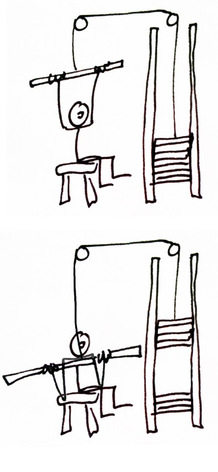|
Oftentimes just trying to add more reps doesn’t quite work. It can, in the long term, but day-to-day, it can also feel kindof pointless and frustrating, depending on what you’re working on, and the mentality you bring to the task. If you want to progress your chin-ups, it’s true that you’ll need to work hard, but it’s better to work at something useful, something that gives you a sense of progress, and to that end, there’s probably something more useful you can do than stubbornly try to muscle through something that isn’t quite working. My usual approach to any technique or exercise is this: identify the weak spot, find exercises that target it specifically, train them, and then in time test your methods by training the original exercise again. See if the weak point has shifted or improved in some way. I think it’s good to remember that what you are testing is the effectiveness of the training methods you have employed, not your worth as a person. If the test fails, then the training methods were ineffective. That’s where the problem lies – there may not be a problem with your work ethic or personality. Instead, it’s just that the training methods did not work for you. Were they poorly prescribed? Did you work too hard or not hard enough? Were the assumptions off? Do you simply need more time or patience before your body can adapt? But I digress. The chin-up, or any exercise that you want to improve: think about the movement. If you’re having trouble getting all the way to the top, rather than simply trying to do more reps, instead forget about the reps and see if you can pause for a second at the top and really squeeze the elbows down into the ribs. Or train more rows, using dumbbells or a cable machine. These techniques will help you when it comes to bringing the elbows close to the ribs. They will help you to complete the top part of the chin-up. If, on the other hand, you have trouble getting started, practice the scapular-pull more to learn how to initiate with the back, or the pullover, or even strict full-range barbell curls, just to practice the action of bending the elbows from a loaded, straight-arm position. All these techniques can help you develop the skill of pulling from an extended position.  I have said before that I don’t find the biceps curl that useful when it comes to improving your chin-ups, but I’ve also known people to train the curl as a protective exercise to strengthen the biceps tendons, and in so doing, support other lifts such as the deadlift. It’s easy to think of the curl as a ‘non-functional’ exercise that’s only used to pump the guns, but any exercise may have multiple applications and benefits depending on what you use it for and what you wish to develop. I don’t really buy into the functional vs non-functional exercise debate, because I tend to think all things have some kind of function, it’s just – that function may not be important to you, it might or might not make sense, and sometimes when you train in certain ways it can make you worse at moving, not better. But I digress, and these are issues for another time. Back to the topic at hand! Thirdly: if you struggle to pull through the middle part of the exercise, consider training the bent-arm isometric hang, where you just hold the middle part for a while, or you might wish to de-load the exercise in some way, use a band for assistance, or a kip with the legs, or train on the seated pull-down machine (pictured) for a while, varying the loading parameters and reps range every week or so. Think about the movement for yourself, what feels strong and what feels weak, and investigate. Most people find the chin-up gets a lot easier when they strengthen their grip. Yet often the grip is not the part that feels weak, because if you can hang from a bar, that part feels like it’s mostly working out right. So consider heavy farmer’s walks as well, and working some direct forearm training into your sessions, even if your grip feels okay. But your perception is important. And your opinion is important too, as is the act of questioning. What can you practice to stimulate the weaker parts of either your body or the action, so that you may grow stronger? Remember, a critical mindset is useful, but a judgemental one is not.
1 Comment
7/16/2024 12:52:15 am
I wanted to express my gratitude for your insightful and engaging article. Your writing is clear and easy to follow, and I appreciated the way you presented your ideas in a thoughtful and organized manner. Your analysis was both thought-provoking and well-researched, and I enjoyed the real-life examples you used to illustrate your points. Your article has provided me with a fresh perspective on the subject matter and has inspired me to think more deeply about this topic.
Reply
Leave a Reply. |
